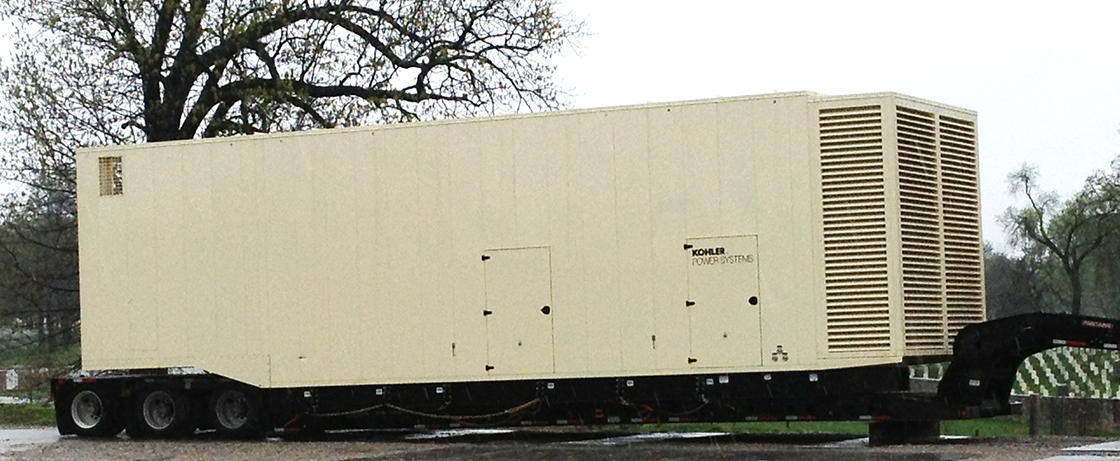
When the Jefferson Barracks Veterans Affairs (VA) Medical Center underwent a $366 million upgrade in 2013, the construction of a central power plant —providing backup power redundancy to patient care buildings— was a key hurdle they needed to overcome. And because the permanent power plant would take two years to complete, a temporary solution was needed to ensure redundancy in the interim.
There were two phases of the project: First designing and building a custom power solution to serve the interim backup power needs of the facility, and then providing the standby generators for the permanent central power plant.
The central power plant was relatively straightforward — three 2500 kW standby generators permanently installed to provide backup power redundancy to their primary backup system. It followed the typical bidding process. There were specifications and the provider had to meet everything in it.
The interim solution didn’t follow standard protocol. There were no specifications and no engineer’s drawings — and an out-of-the-box solution wouldn’t work. And any solution proposed to the medical center had to pass muster with the U.S. Army Corps of Engineers.
Many bid on the central power plant. Few submitted bids for the interim solution. CK Power bid, won and delivered a solution for both. And now VA centers across the Midwest are making use of CK Power’s design-build power solution.
Designing and building a custom interim power solution
While this was far from a standard project, it was well within CK Power’s wheelhouse. With a team of experienced, tenured engineers and service technicians on staff, CK Power was willing and able to think outside of the box to provide a design-build power solution.
During the course of this project, we not only relied on the breadth and depth of experience we have in house, but we also worked closely with our partners —each with a varying area of expertise— to meet the needs of the medical center.
Four trailers, two generators, 24,600 gallons of fuel
The interim solution we proposed during the pre-sale process consisted of two 2500 kW prime power diesel generators mounted on a trailer. Each generator had a 300-gallon internal fuel tank. Then we had two trailer-mounted 12,000 gallon fuel tanks —one for each generator— to subsidize fuel needs. Fuel was plumbed into the corresponding generator with fuel lines and pumps. The paralleling gear would be mounted on the ground.
Designing a special-built enclosure to house a 2500 kW generator
Typically, a 2000 kW generator is the largest you’ll see in a trailer-mounted configuration — but this wasn’t a typical application. To create an enclosure large enough to fit a larger kW generator while providing the functionality and sound attenuation the client required, we had to look beyond typical solutions. We partnered with Global Power Components to produce a 40-foot special-built enclosure tailored precisely to the application for the two generators.
Creative solutions for hauling 80,000-pound generator trailers
The generators alone weighed about 60,000 pounds each. Add in the enclosures and equipment housed inside, and you’re at about 80,000 pounds. To transport these custom power units to the VA medical center campus, we needed a specialized hauling trailer. The fuel tanks were small enough to be mounted on a standard flatbed trailer.
Holthaus Truck Service, Inc. —which specializes in hauling heavy-duty equipment— helped us design and source the right trailer for transporting the generator. In the end, we used a 50-ton trailer sourced from Fontaine Heavy-Haul equipped with extra wheels to help carry the weight. The trailer we chose not only sustained the substantial weight of the generators, equipment and enclosures, but they also met the Federal Highway Administration (FHWA) requirements, allowing for safe transit to their destination.
Collaborating with Kohler to prove EPA Tier 4 interim compliance
The tier transition for EPA emissions regulations —from Tier 2 to Tier 4— was happening at the same time that we were designing the temporary power units for the medical center. Because of this, we had to prove compliance with the EPA’s Transition Program for Equipment Manufacturers (TPEM).
This meant we had to prove the engines used in the custom power units complied with EPA TPEM requirements. As a Kohler distributor, we used Kohler generators in the units — and only the manufacturer of the original engines is eligible to apply for participate in the transition program.
Small details like this TPEM sticker might not even be noticed by the VA center, but without them, they wouldn’t have been able to use the custom power units. We worked closely with Kohler behind the scenes to obtain the appropriate TPEM stickers to prove that our custom units complied.
Ensuring long-term compliance with the right maintenance, testing and records
The Jefferson Barracks VA medical center used our custom power units for two years to provide redundant backup power to its campus while the permanent power plant was being constructed.
Today, its backup power is provided by three of our 2500 kW diesel standby generators and the custom power units we created are being used by Marion VA Medical Center. But our work with the Jefferson Barracks VA Medical Center is far from finished.
Through our preventative maintenance program, we perform all of the maintenance, testing and recordkeeping to ensure ongoing compliance with the Joint Commission, the NEC®, NFPA 110 and NFPA 99.
Let us help you engineer the impossible
CK Power has a full line of standard power products, and an engineering team capable of designing never-before-seen solutions for almost any application. First-in-class battery charging containers, first-on-ground 1000+ kW Tier 4 Final generators, fitting Tier 4 engines into tight space claims — anything.
Get in touch with us today to learn how we can design and build a custom power solution for your application, no matter how impossible it may seem. You’ll have a response in 48 hours